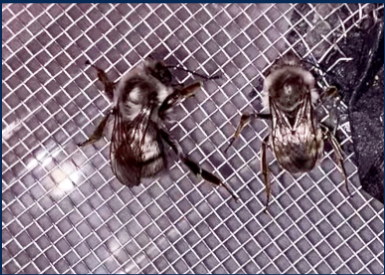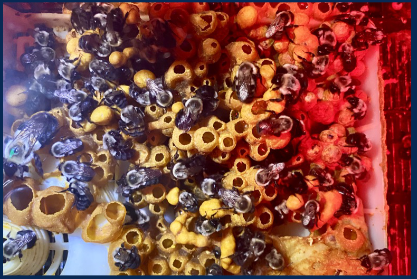microRNA in Common Eastern Bumblebee Physiology and Behavior
microRNA in Common Eastern Bumblebee Physiology and Behavior PDF File
Objective:
Determine if, and for how long, a miRNA antagomir can knockdown miR-13b and influence gene expression related to physiology and behavior.
Introduction
Eusociality is a social system involving division of labor resulting in a caste system, such as the queen and the worker castes in the Common Eastern Bumblebee, Bombus impatiens. These two castes display different physiologies, despite their shared genome, measured by 1) ovary size and 2) nutrient stores in the fat body.
We aim to investigate the role of a microRNA sequence called miR-13b in causing these physiological differences between queens and workers by interfering with the expression of miR-13b. We will use an antagomir which will reduce the effect of miR-13b on gene expression.
- We hypothesize that altered gene expression due to miR-13b knockdown will result in changes to the expressed phenotypes which will be measured by ovary size and fat body development, both traits that are physiological correlations of division of labor.
Methods
- Inject 2-day old bees with the antagomir of miR-13b
- Dissect abdomens to isolate the ovaries and fat bodies to look for the effects of the antagomir
- Extract RNA from those tissues
- Analyze the resulting RNA through quantitative polymerase chain reaction (qPCR)
- Relative gene expression will be measured using the 2-ΔΔCT method


Closeup image of two newly emerged bees and the colony they were pulled from.
Results
We have collected and treated 109 bumblebee samples. (Table 1)
| Day 3 | Day 4 | Day 6 | Day 10 | Total | |
|---|---|---|---|---|---|
| 900 Ant | 7 (0.875) | 7 (1.00) | 7 (0.583) | 5 (0.625) | 26 |
| 900 Scr | 9 (1.00) | 8 (0.889) | 8 (0.8) | 8 (0.8) | 33 |
| 450 Ant | 6 (1.00) | 8 (0.889) | 8 (0.8) | 8 (0.8) | 33 |
| 450 Scr | 6 (1.00) | 6 (1.00) | 6 (0.75) | 6 (0.875) | 24 |
| Total | 30 | 28 | 27 | 24 | 109 |
- The treatment groups include bees injected with either 450 µM or 900 µM of antagomir. Control groups were injected with scrambled sequences of the same doses (450 µM or 900 µM).
- Treatment lengths are 3, 4, 6, and 10 day periods from injection to freezing.
- Survival was lowest for days 6 and 10 but had similar rates between treatments.
Next Steps
Currently we are still making progress towards our objectives of
- If the antagomir dosage can be increased to influence expression for more than one day
- Assessing physiological changes in ovaries and fat body due to the antagomir treatment
- What behavioral changes result from antagomir knockdown
Specifically, we aim to increase the sample size to 9 per treatment group (144 total), proceed with ovary/fat body dissections, and isolate RNA.

